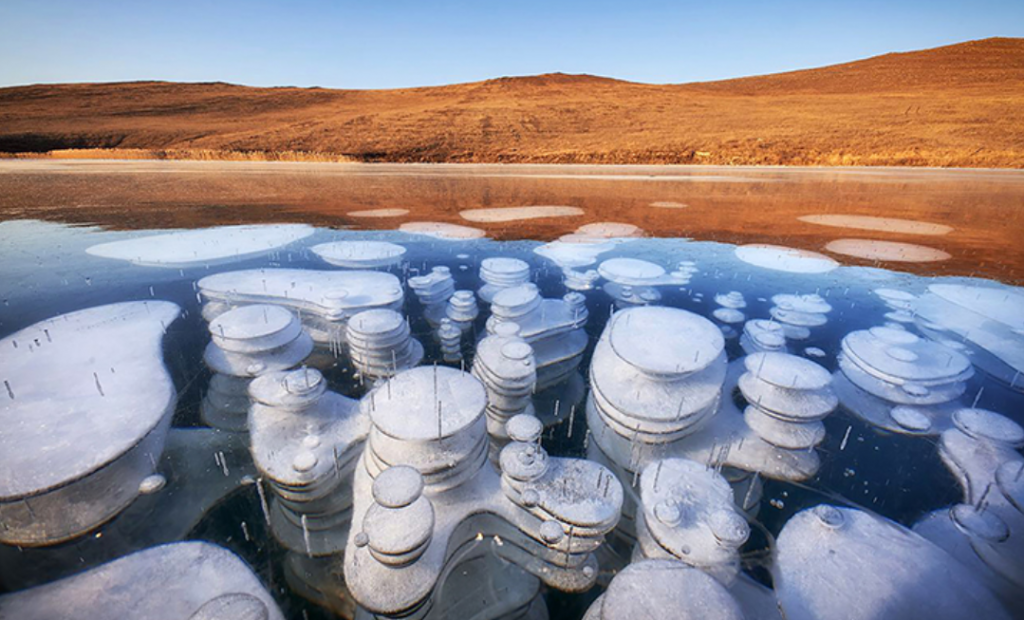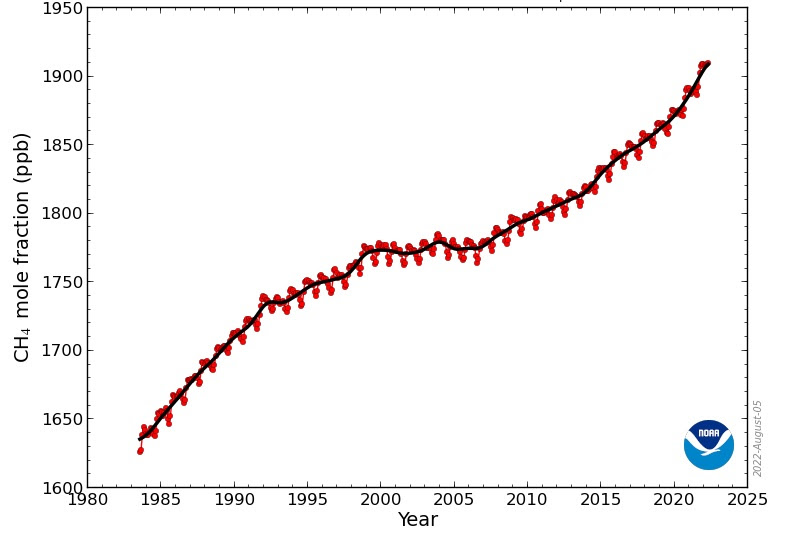By Jennifer Le
Courtesy of ENERGYminute
See more articles and infographics from ENERGYminute HERE

Methane bubbles trapped in ice in Russia courtesy of the Siberian Times
For all the extra heat that methane traps, it gets far less media attention than carbon dioxide. But just like Leo and any girlfriend that just turned 25, that relationship is about to stop.
Recent debates have fiercely argued where additional methane in the atmosphere is coming from and a new study may finally have some answers.
Background: Atmospheric methane levels have been increasing since 2007, reaching three times their pre-industrial levels.
- Even with the pandemic, the rise of methane remained unstopped.
This is not ideal, as methane is a much more potent greenhouse gas, trapping 80 times more heat that carbon dioxide in the first 20 years that it remains in the atmosphere.
Global atmospheric methane, 1980-2022
parts per billion

Courtesy of NOAA Global Monitoring Laboratory
So why are methane emissions increasing?
Between 2000 and 2007, atmospheric methane was relatively flat with no clear consensus among scientists as to why.
- One guess is that the collapse of the Soviet Union caused a decrease in industrial output in the early 2000s. Another was that developed countries had better-managed fugitive emissions from oil and gas during that time.
Where does methane come from?
annual megatonnes of methane by source

Courtesy of the International Energy Agency
Surprisingly, the largest source of methane globally isn’t from human activity, but from swamps (depends how you count Shrek). For human contributions, farming is the biggest global input of methane followed by energy extraction.
What scientists found recently: Scientists can now check where methane comes from based on which carbon isotope is found in the particle.
- As a quick science refresher, isotopes are the same element but with a different number of neutrons.
Methane from fossil fuels have more carbon-13 isotopes and ever since the Industrial Revolution, there has been an increase in carbon-13 in the atmosphere. However, since 2007, the rise in atmospheric methane has mainly been comprised of carbon-12, indicating that fossil fuels may not be the main source of new methane.
The culprits: There are several reasons proposed by scientists on what could be driving the global growth in methane:
Cows and garbage. Satellite images show increased methane coming from tropical regions in South America where cattle ranching and landfill development have increased.
Wetlands are getting wetter. When wetlands receive more rain, microbes have more organic matter to eat, leading to increased methane production.
- This is seen in East Africa, specifically from Sudd, the largest swamp in South Sudan.
Previously, scientists were unable to study the wetlands on the ground due to conflict in that region. But thanks to advances in satellite technology, scientists can now see the scale of the methane emitted from that area.
Energy’s role: This doesn’t mean that fossil fuel extraction is entirely scot-free, though. Methane emissions have certainly increased in the United States during the past decade because of increased hydraulic fracturing. But new methods for pinpointing fugitive methane emissions — like satellites and infrared ground technologies — can help companies better identify the leaks in their operations and address them.
Zoom out: While the causes for the rise (and previous fall) in methane remain unresolved, data from the Global Monitoring Laboratory underscores the importance of concerted efforts focused on decreasing methane emissions.
- Many countries pledged to reduce methane emissions by 30 percent in COP26 and the United States recently put a price on methane.
On top of climate pledges, technological advances and targeted actions by both governments and companies will help slow the alarming rise in methane levels.
+ Video: 3D Visualization of Sources of Methane from NASA
++ Additional Infographics: Global Carbon Project Methane Budget
Share This:




 CDN NEWS |
CDN NEWS |  US NEWS
US NEWS 


























